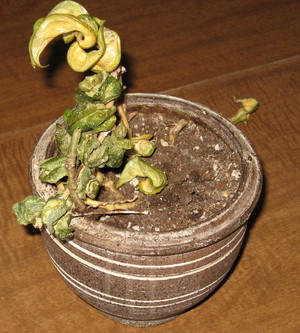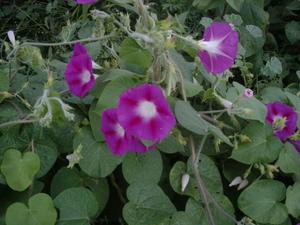I am an Horticulturist and for 36 years I worked in interior tropical greenhouses. I specialized in interior tropical plants; houseplants. Many of my houseplants are gems I grew form small cuttings that have developed into large, lush specimens. Even though my home does not have a great amount of natural light, I selected the types of plants that would grow well in the amount of light I can provide for them. I have many plants in my home and have put them in groups of gardens in different rooms where the light levels are the highest. These gardens are groupings of plants that take the same light levels and the same water requirements. The plants are in decorative pottery that enhances the color of the leaves of each plant as well as the color schemes of the individual rooms. They are a focal point upon entering the room.
Of all the web sites I visited in reference to houseplant insects, I have not yet found one that gives a thorough description of how to get rid of insects once and for all, or how to prevent them in the first place. These next few articles in this series will list all the methods I use to keep my plants healthy and insect free-or at least how I keep insects at bay. Keeping them totally insect free is next to impossible. The bugs are out there and they will get to your plants at one time or another. That is nature’s way. I will help you to learn how to identify them and what to do when you see them on your plants. The articles will be in the order that my experiences find those infestations hardest to destroy with least harm to the plants.
As I was learning about plant maintenance throughout the years, I learned the importance of clustering like plants together to increase the humidity around the grouping, as well as in the room. This clustering is great in providing humidity but it is also one way for insects to spread easily from one plant to another.
Those insects that affect houseplants have mouthparts that penetrate the surface of the plant and suck nutrients from it. The breathing holes are on either side of the body, allowing the bug to breath while it is feeding. Mealy bug is an insect covered with a white, sticky, waxy-like substance that protects the soft, brown body within. It allows water to run off the body, having no effect on the insect at all. The egg sacs are the cottony-like sacs found along vein lines on the top and bottom of leaves as well as in the crevices of leaf nodes and stems. The egg sacs can also develop around the root ball inside the pot. The egg sacs start out as tiny flecks of a dust-like substance that floats on air currents and is carried though the rooms in your home. These sacs will travel until they hit a surface and then will adhere to that surface until the time is right for the eggs inside to swell and grow. These sacs can remain on a rough surface, such as the underside of a shelf or window sill for up to ten years waiting until temperature and humidity are right for growth and development.
Once an egg hatches, the miniature adult climbs to the nearest plant and inserts its mouth parts into the plant surfaces and begins feeding. It will remain this way for as long as the nutrient flow provides enough for the insect’s needs. The insects multiply rapidly and within a few weeks, an infestation can cover a plant. If left untreated, the infestation will kill the plant in time. As the females lay more egg sacs, they will accumulate and with any movement of the leaves by wind or other disturbance, they will float on the air currents to other areas. The adults can also crawl from one plant to another and when the plants are close to each other, the spread of the insects is that much easier. Mealy can fall in to your watering can and fall in to the soil of other plants with the water. If a pet happens to brush an infested plant, mealy can fall on its fur and travel to the next food source by hitching a ride.
One of the major signs of mealy on a plant is a sticky glaze that may cover one or several leaf surfaces. This is the secreation of the insects that falls from an infested leaf above. This honey dew may fall on the flooring or furniture beneith the plant and dissolves easily with warm water.
Of all the insects that infest houseplants, I consider the mealy bug to be the most difficult to get rid if entirely. The main reason is because of the egg sac’s ability to remain dormant for so long and still be viable. The treatment for this insect takes time, dedication and persistence. To treat an infestation, you need to make a total commitment to your plant. If you do not, the insects will win every time–garanteed.
Meal bug is a type of soft-shelled scale. I will cover other scale insects in the next article. The waxy-like substance covering the body acts like a shield against moisture, either evaporating or penetrating. This makes using some substances ineffective in harming the body beneath. Because the shells are soft, it is easy to kill the insects by rubbing them with you fingers and squashing them. This is the most effect method of killing the bugs without harm to you or the plant. They cannot develop and effective immunity to this method, although it is a bit messy. This is also the only truly organic method of killing the insects. The other alternative is with the use of chemicals.
One of the best chemicals that has an instant effect on the insect is rubbing alcohol. It immediately dissolves the waxy covering exposing the body and it dies very quickly. This must hit the body to be effective and has no lingering power to affect any other adults or egg sacs. It only works for mealy bug and will not affect any of the other insects that attack houseplants. The alcohol evaporates very quickly so it does not harm the foliage unless it is used in too high a dosage. I often put the alcohol in a spray bottle and spray the foliage to the dripping point, trying not to saturate the soil or the delicate tips, as the alcohol can burn new foliage. Rinsing the leaves after spraying helps to minimize leaf burn on the older leaves.
Horticultural oil is also very effective in killing meal bug. The oil covers the mouth parts, causing the insect to suffocate. This is also an effective way to kill them as the insects cannot build up an immunity against suffocation. There is, however, no chemical that is totally safe and not-toxic. The whole point of the chemical is to kill, and the only safe part comes with using it according to the manufacture’s recommendations. I have seen on too many occasions how the excess of these chemicals have killed the plant before it has affected the insect population.
Alcohol is effective and safe if you use it every couple of days rather than daily. For a really heavy infestation–one where the insect seems to be everywhere on the plant, you will need to us the three above methods to be even a little bit effective in getting rid of the problem. First, spray the horticultural oil on every part of the plant. You need to spray in an area where the residue will not harm pets or other people; a separate room or basement. Let the plant dry thoroughly before bringing it back to its place. Make sure you never use any insecticide when the plant is in sun as it will cause sever burning to the leaves.
This is the first step on day one. The second step is the next day to spray any egg sacs you find with alcohol. After the alcohol dries, you must use your fingers to eradicated any other individuals or sacs you find. Repeat this daily until day seven when you can spray with the chemical once again. You need to repeat this procedure daily, cleaning with the hands, using the rubbing alcohol, and spraying weekly with the insecticide until you do not find any new insects for two straight weeks. And, yes, this is a lot of work but if you are not diligent with the daily program, I can guarantee you will never get rid of the infestation completely. It will always come back after a bit.
But you must also clean the areas around the infected plants because the eggs can be on the shelves, curtains, windows, fixtures, or any other surface close to the plants. Be sure to remove all the plants from the area where they stay, and clean it well with a mild solution of warm soapy water. The sponge or cleaning rag is very effective in eradication of dormant egg sacs.
Many of my customers have mentioned using dish detergent as an insecticide. In all of my experiences with plants where the owner used dish detergent, even in a mild solution, resulted in sever foliage burn. And if the solution gets into the soil and is not rinsed out immediately, the roots can also suffer to the point of plant death.
Because this is such a time consuming method of eradication, the best method is by preventing the problem in the very beginning. As I stated earlier, insects are out there and they are looking for food. If you can take a few moments one day each week to carefully inspect each plant, you are in the best position to stop an infestation completely. Check each plant by looking on the top and bottom of leaves, checking the branches and stems, and looking at the soil; you will see anything that may develop in to something that may harm your plant. An infestation begins with just one or two individuals, and by killing any bugs with your fingers, there will never be a problem. If, of course, you let several weeks or months go by, then you may find a big problem. Again, it is being in this routine of careful examination that is most beneficial to you and your plants.
I cannot stress the importance of this weekly check because the consequences are so difficult to eradicate and all too often the plant dies long before the insect infestation. I have lost many prized plants to the treatment of an infestation. The chemicals take a toll on your plants, especially if the plants are weakened by an infestation. By giving your plants all the light they need, the proper amount of water they require, and an occasional solution of fertilizer, you can keep your plants healthy and strong and that will help them fight off any insects that may try to munch on them.
I want to mention one major factor that often is a cause for an insect infestation. This is placing your plants outside for the summer months. Because the United States has a tropical-like summer, tropical plants thrive when placed out side where they will get high light, high humidity, and gentle warm breezes–all the elements for a thriving plant. (See the article Placing houseplants outside for the summer.) This is not where the problem lies. It is when you bring the plants back in for the winter months that cause the plant to weaken due to the lower light and humidity levels. When the light level drops, the plant cannot sustain all the beautiful new growth of summer, and drops all the leaves it needs to balance the amount of food production with the amount of foliage. When being out side, the plant is also subjected to all the insects in nature, and combined with the weakened effect of the reduction in light, an infestation can gain hold even faster than if the plant remained inside all summer.
These are proven methods of eradication and prevention of insect infestations on houseplants. With patience and persistence, they work every time in helping to keep all your indoor plants healthy and strong.
Here is a list of indoor plants that mealy bug love:
-African Violets–streptocarpus (Cape Primrose)–All Succulents and Cactus–All Ficus–All Hdera (Ivies)–All Beginias —Most Dracaena species–Clivia–Aglonema (Chinese Evergreen)–Coelus–Dieffenbachia (Dumb cane)–Anthurium Hibiscus–Poinsettia (Which is a succulent. See “Oh those Pionsettias!”)–Philodendren and Pothos (Devil’s’ Ivy)
-All Genariads: Aescanthanthus Lipstick vine), Columnea (Goldfish Plant), Epescia
-Fittonia–All Citrus–Gardenia–Dizygotheca (Fales Aralia)–Fatsia (Japinese Aralia)–Gynura (Purple Passon)
-All Hedera (Ivy)–Strlitizia (Bird of Paradise)–Heliconia–Heptaplerurum (Arboricala)–Scheflera–Hypostes (Pola-a-dot Plant)–Mantra (Prayer Plants)Plectranthus (swedish Ivy)–Podocarpus (Buddhist Pine)–Saxifraga (Strawberry Begonia)–Senicia (Geraman Ivy)–cisus and Rhoicussus (Grape Ivy)–Tetrastigma (Chesnut Vine or Lizzard Plant)
-All Orchids.
As you can see, the list is extensive. In fact, there are very few of the tropical indoor species that mealy bug will not attack. So be on the loolout for them before they become a major problem.
HAPPY GARDENING





